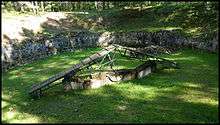Paneriai
- For the massacre during World War II of Jews, Polish intelligentsia, and Soviet POWs see Ponary massacre. For the Polish village of the same name, see Ponary.


Paneriai is a neighborhood of Vilnius, situated about 10 kilometres away from the city center. It is the largest elderate in the Vilnius city municipality. It is located on low forested hills, on the Vilnius-Warsaw road. Paneriai was the site of the Ponary massacre, a mass killing of as many as 100,000 people from Vilnius and nearby towns and villages during World War II.
History
The village was probably founded some time in the 14th century. In 1390, it was acquired by the Vilnius Bishopric and soon became the main supplier of bricks to the nearby city. It shared a common history with Vilnius. After the final Partition of Poland in 1795, it became a part of the Vilna Governorate of the Russian Empire. During the November Uprising, on June 19, 1831, the Battle of Ponary took place near the village, in which the forces of Dezydery Chłapowski and Antoni Giełgud were defeated by Russian infantry.
As result of Russia's withdrawal from World War I, and the signing of the Treaty of Brest-Litovsk, the area was occupied by German forces and transferred to Belarusian People's Republic. With Germany's defeat several months later the territory underwent significant political upheaval, but following the Polish-Bolshevik War, and the Polish-Lithuanian War, it eventually became occupied by Poland. In 1939, after the Invasion of Poland (1939), the village was captured by the Soviet Union and transferred to Lithuania, only to be reannexed by Soviets the following year.
Between July 1941, and August 1944, Paneriai became the mass murder site of approximately 70,000[1]Jews, 20,000 Polish intelligentsia, and 8,000 Russian POWs.[2][3][4] The executions were carried out by German units of SD and SS with help from local Lithuanians Special SD and Security Police Squad Ypatingasis būrys.[4][5][6] The site of the massacre is commemorated by a memorial to the victims of the Holocaust, a memorial to the Polish victims and a small museum (currently closed).
Since 1990, again part of independent Lithuania, it was recently incorporated to the city of Vilnius as one of its districts.
See also
References
- ↑
- ↑ Kazimierz Sakowicz, Yitzhak Arad, Ponary Diary, 1941-1943: A Bystander's Account of a Mass Murder, Yale University Press, 2005, ISBN 0-300-10853-2, Google Print.
- ↑ Tadeusz Piotrowski, Poland's Holocaust, McFarland & Company, 1997, ISBN 0-7864-0371-3, p.168
- 1 2 (Polish) Śledztwo w sprawie masowych zabójstw Polaków w latach 1941 - 1944 w Ponarach koło Wilna dokonanych przez funkcjonariuszy policji niemieckiej i kolaboracyjnej policji litewskiej (Investigation of mass murders of Poles in the years 1941-1944 in Ponary near Wilno by functionaries of German police and Lithuanian collaborating police). Institute of National Remembrance documents from 2003 on the ongoing investigation]. Last accessed on 10 February 2007.
- ↑ (Polish) Czesław Michalski, Ponary - Golgota Wileńszczyzny (Ponary - the Golgoth of Wilno Region). Konspekt no. 5, Winter 2000/2001, a publication of Academy of Pedagogy in Kraków. Last accessed on 10 February 2007.
- ↑ Arūnas Bubnys (2004). Vokiečių ir lietuvių saugumo policija (1941–1944) (German and Lithuanian security police: 1941-1944) (in Lithuanian). Vilnius: Lietuvos gyventojų genocido ir rezistencijos tyrimo centras. Retrieved 2006-06-09.
Coordinates: 54°38′08″N 25°11′30″E / 54.6356°N 25.1917°E